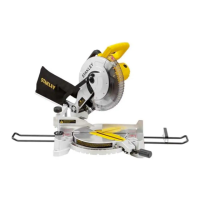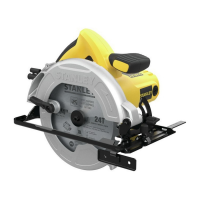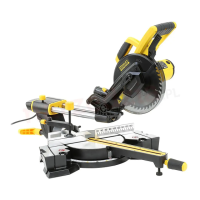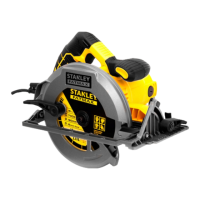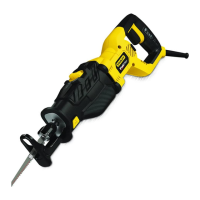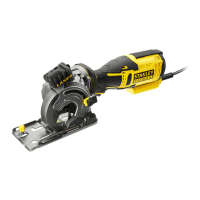26 • ENGLISH
f GUARD ACTUATION AND VISIBILITY.
The blade guard on your saw has been designed to
automatically raise when the arm is brought down
and to lower over the blade when the arm is raised.
The guard can be raised by hand when installing or
removing saw blades or for inspection of the saw.
Never raise the blade guard manually unless the saw
is turned off.
Note: Certain special cuts will require that you
manually raise the guard. To do this, simply place your
right thumb on the upper side of the guard and roll the
guard up just enough to clear the workpiece. Never tie
up or otherwise prevent the guard from operating
normally.
OPERATION
Plug the saw into any power source. Refer to the
nameplate for voltage. Be sure the cord will not interfere
with your work.
Switch
To turn the saw on, depress the trigger switch (16). To turn
the tool off, release the switch. There is no provision for
locking the switch on.
Body and hand position (see FIG. G)
Proper positioning of your body and hands when operating
the miter saw will make cutting easier, more accurate and
safer. Never place hands near cutting area. Place hands no
closer than 6” from the blade. Hold the workpiece tightly to the
table and the fence when cutting. Keep hands in position until
the trigger has been released and the blade has completely
stopped.
Always make dry runs (unpowered) before finish
cuts so that you can check the path of the blade. do not
cross hands, as shown in
Fig. G.
CUTTING WITH YOUR SAW
Note: Although this saw will cut wood and many nonferrous
materials, we will limit our discussion to the cutting of wood
only. The same guidelines apply to the other materials. Do not
cut ferrous (iron and steel) materials or masonry with this saw.
Do not use any abrasive blades.
CROSSCUTS
Note: Cutting of multiple pieces is not recommended, but
can be done safely by ensuring that each piece is held
firmly against the table and fence. A crosscut is made by
cutting wood across the grain at any angle.
f A straight crosscut is made with the miter arm at the
zero degree position. Set the miter arm at zero,
hold the wood on the table and firmly against the
fence. Turn on the saw by squeezing the trigger switch.
f When the saw comes up to speed (about 1 second)
lower the arm smoothly and slowly to cut through
the wood. Let the blade come to a full stop before
raising arm.
f Miter crosscuts are made with the miter arm at some
angle other than zero. This angle is often 45º degrees
for making corners, but can be set anywhere from
zero to degrees left or right. After selecting the
desired miter angle, be sure to tighten the miter clamp
handle (4). Make the cut as described above.
BEVEL CUTS
A bevel cut is a crosscut made with the saw blade at a
bevel to the wood. In order to set the bevel, loosen the
bevel clamp knob (10) and move the saw to the left as
desired. Once the desired bevel angle has been set,
tighten the bevel clamp knob firmly. Bevel angles can be
set up to 45º degrees left and can be cut with the miter
arm set between zero and 47º degrees right or left.
QUALITY OF CUT
f The smoothness of any cut depends on a number of
variables. Things like material being cut, blade type,
blade sharpness and rate of cut all contribute to the
quality of the cut.
f When smoothest cuts are desired for molding and
other precision work, a sharp (60 tooth carbide)
blade and a slower, even cutting rate will produce the
desired results.
f Ensure that material does not creep while cutting,
clamp it securely in place. Always let the blade come
to a full stop before raising arm.
f If small fibers of wood still split out at the rear of the
workpiece, stick a piece of masking tape on the wood
where the cut will be made. Saw through the tape and
carefully remove tape when finished.
f Keep both feet firmly on the floor and maintain proper
balance. As you move the miter arm left and right,
follow it and stand slightly to the side of the saw blade.
Sight through the guard louvers when following a
pencil line.
CLAMPING THE WORKPIECE
Turn off and unplug saw
f If you cannot secure the workpiece on the table and
against the fence by hand (irregular shape, etc.) or
your hand will be within 6” of the blade, a clamp or
fixture must be used.
f Other convenient clamps such as spring, bar or C
clamps may be appropriate for certain sizes and
shapes of workpieces. Use care in selecting and
placing these clamps and make a dry run before
making the cut.
SUPPORT FOR LONG PIECES
Turn off and unplug saw. Always support long
pieces.
For best results, use an extension work support to extend
the table width of your saw. Support long workpieces
using any convenient means such as sawhorses or similar
devices to keep the ends from dropping.
